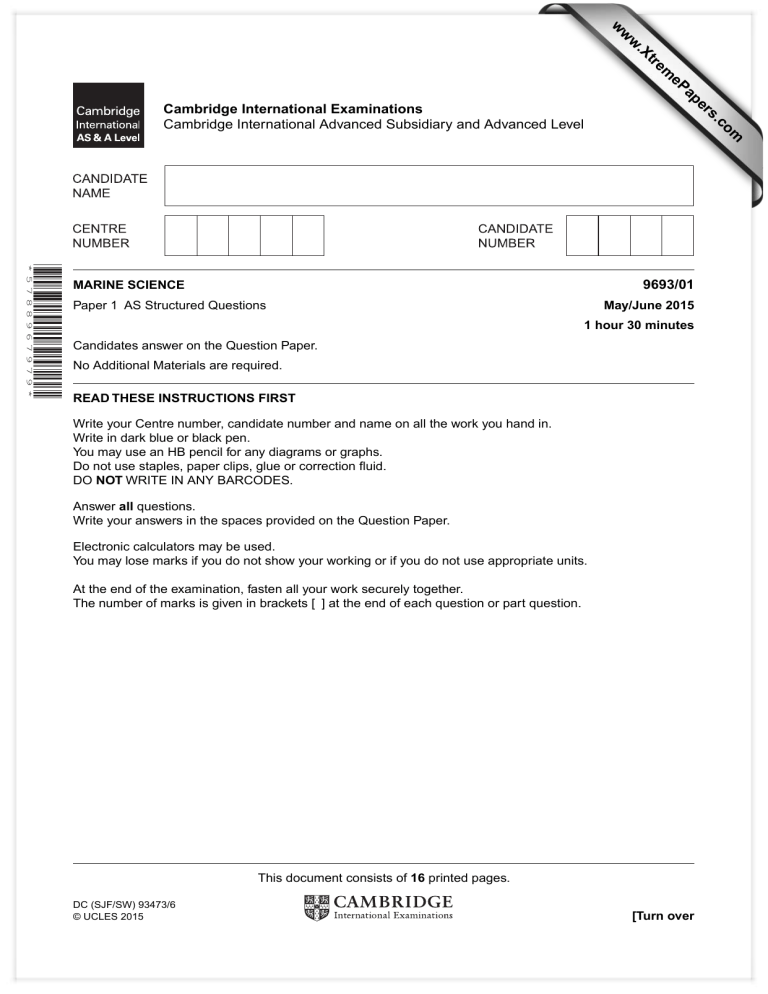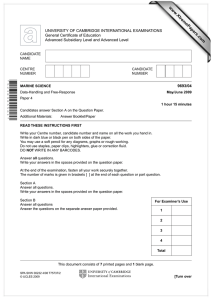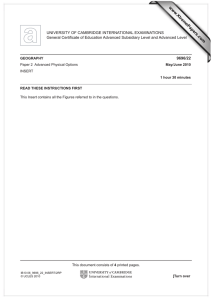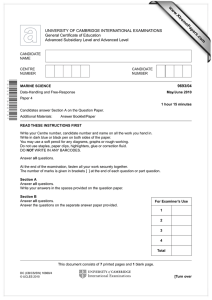www.XtremePapers.com Cambridge International Examinations 9693/01 Cambridge International Advanced Subsidiary and Advanced Level
advertisement

w w ap eP m e tr .X w om .c s er Cambridge International Examinations Cambridge International Advanced Subsidiary and Advanced Level * 5 7 8 8 9 6 7 9 7 9 * 9693/01 MARINE SCIENCE Paper 1 AS Structured Questions May/June 2015 1 hour 30 minutes Candidates answer on the Question Paper. No Additional Materials are required. READ THESE INSTRUCTIONS FIRST Write your Centre number, candidate number and name on all the work you hand in. Write in dark blue or black pen. You may use an HB pencil for any diagrams or graphs. Do not use staples, paper clips, glue or correction fluid. DO NOT WRITE IN ANY BARCODES. Answer all questions. Write your answers in the spaces provided on the Question Paper. Electronic calculators may be used. You may lose marks if you do not show your working or if you do not use appropriate units. At the end of the examination, fasten all your work securely together. The number of marks is given in brackets [ ] at the end of each question or part question. This document consists of 16 printed pages. DC (SJF/SW) 93473/6 © UCLES 2015 [Turn over 2 Answer all the questions in the spaces provided. 1 (a) Fig. 1.1 shows three types of tectonic plate boundary, A, B and C. A B C Fig. 1.1 (i) © UCLES 2015 Draw one arrow on the surface of each plate to show the movement of the plates at each boundary. [3] 9693/01/M/J/15 3 (ii) Name or describe the type of tectonic plate boundary at which the following are formed. mid-ocean ridges ............................................................................................................... ........................................................................................................................................... ........................................................................................................................................... ocean trenches .................................................................................................................. ........................................................................................................................................... ........................................................................................................................................... volcanoes .......................................................................................................................... ........................................................................................................................................... .......................................................................................................................................[3] (b) Movements at tectonic plate boundaries can create deep cracks in the sea bed. Explain how hydrothermal vents form in these areas. ................................................................................................................................................... ................................................................................................................................................... ................................................................................................................................................... ................................................................................................................................................... ................................................................................................................................................... ................................................................................................................................................... ................................................................................................................................................... ................................................................................................................................................... ................................................................................................................................................... ................................................................................................................................................... ................................................................................................................................................... ................................................................................................................................................... ................................................................................................................................................... ...............................................................................................................................................[5] [Total: 11] © UCLES 2015 9693/01/M/J/15 [Turn over 4 2 (a) Fig. 2.1 shows the levels of sunlight, the concentration of dissolved nutrients, and the numbers of phytoplankton from February to September in the surface layer of the Mediterranean Sea. Key sunlight February March April dissolved nutrients May June July phytoplankton August September month Fig. 2.1 (i) Suggest explanations for the increase in the numbers of phytoplankton during March and April. ........................................................................................................................................... ........................................................................................................................................... ........................................................................................................................................... ........................................................................................................................................... ........................................................................................................................................... ........................................................................................................................................... ........................................................................................................................................... .......................................................................................................................................[3] (ii) Suggest why the concentration of dissolved nutrients falls during April and May. ........................................................................................................................................... .......................................................................................................................................[1] (iii) © UCLES 2015 Sketch a line on Fig. 2.1 to predict the changes in the numbers of zooplankton from February to September. [3] 9693/01/M/J/15 5 (b) Fig. 2.2 shows the energy flow in a marine ecosystem. The numbers are arbitrary units (a.u.) light energy from Sun 8 million a.u. light energy received by producers 2 million a.u. energy lost by respiration 60 850 a.u. energy in bodies of producers 92 000 a.u. energy lost by death and decay 21 980 a.u. energy in bodies of primary consumers Fig. 2.2 Use the information in Fig. 2.2 to answer the questions below. (i) State the number of arbitrary units of energy which are the result of primary productivity. .......................................................................................................................................[1] (ii) Calculate the number of arbitrary units of energy transferred to the primary consumers. ............................................[1] (iii) Suggest the number of arbitrary units of energy which would pass to the secondary consumers. .......................................................................................................................................[1] (iv) State the form in which energy is lost to the environment by respiration. .......................................................................................................................................[1] © UCLES 2015 9693/01/M/J/15 [Turn over 6 (c) Describe the similarities and differences between chemosynthesis and photosynthesis. similarities ................................................................................................................................. ................................................................................................................................................... ................................................................................................................................................... ................................................................................................................................................... ................................................................................................................................................... differences ................................................................................................................................ ................................................................................................................................................... ................................................................................................................................................... ................................................................................................................................................... ...............................................................................................................................................[4] [Total: 15] © UCLES 2015 9693/01/M/J/15 7 3 (a) Fig. 3.1 shows some of the feeding relationships in a coral reef food web. sharks sea turtles damselfish box jellyfish triggerfish butterflyfish angelfish sea urchins pufferfish giant clams corals krill seagrass marine algae fan worms phytoplankton Fig. 3.1 (i) Name the producers in the food web in Fig. 3.1. ........................................................................................................................................... .......................................................................................................................................[1] (ii) (iii) The crown-of-thorns starfish is a predator of corals and is eaten by triton snails. Add this information to Fig. 3.1. [2] Giant clams are harvested by humans for food and are now an endangered species. Suggest and explain a possible effect on the population of sea turtles if the giant clams become extinct. ........................................................................................................................................... ........................................................................................................................................... ........................................................................................................................................... .......................................................................................................................................[2] © UCLES 2015 9693/01/M/J/15 [Turn over 8 (iv) Explain why sharks are said to occupy general ecological niches. ........................................................................................................................................... ........................................................................................................................................... ........................................................................................................................................... ........................................................................................................................................... ........................................................................................................................................... .......................................................................................................................................[3] (b) Suggest and explain why tropical corals do not normally live in water at a depth of 60 metres or more. ................................................................................................................................................... ................................................................................................................................................... ................................................................................................................................................... ................................................................................................................................................... ................................................................................................................................................... ...............................................................................................................................................[3] [Total: 11] © UCLES 2015 9693/01/M/J/15 9 4 (a) State how fish and corals make use of calcium. fish ............................................................................................................................................ ................................................................................................................................................... corals ........................................................................................................................................ ...............................................................................................................................................[2] (b) Fig. 4.1 shows how calcium is cycled between the land and the sea. land humans D nutrients in surface layer of the sea G bodies of fish E F sea bed Fig. 4.1 (i) Name processes D, F and G. D ........................................................................................................................................ F ........................................................................................................................................ G ...................................................................................................................................[3] (ii) Describe how calcium on land becomes a nutrient in the surface layer of the sea. ........................................................................................................................................... ........................................................................................................................................... ........................................................................................................................................... ........................................................................................................................................... ........................................................................................................................................... .......................................................................................................................................[3] © UCLES 2015 9693/01/M/J/15 [Turn over 10 (iii) Describe process E. ........................................................................................................................................... ........................................................................................................................................... ........................................................................................................................................... ........................................................................................................................................... ........................................................................................................................................... .......................................................................................................................................[3] [Total: 11] © UCLES 2015 9693/01/M/J/15 11 5 (a) State three possible causes of erosion of coral reefs. 1 ................................................................................................................................................ ................................................................................................................................................... 2 ................................................................................................................................................ ................................................................................................................................................... 3 ................................................................................................................................................ ...............................................................................................................................................[3] (b) Concrete reef balls are often used to make artificial reefs. Fig. 5.1 shows a reef ball before use. Fig. 5.2 shows a reef ball after being submerged for 12 months. Fig. 5.1 (i) Fig. 5.2 Suggest and explain two properties of the reef balls that make them suitable for constructing an artificial reef. Give a reason for each answer. 1 ........................................................................................................................................ ........................................................................................................................................... ........................................................................................................................................... ........................................................................................................................................... 2 ........................................................................................................................................ ........................................................................................................................................... ........................................................................................................................................... .......................................................................................................................................[4] © UCLES 2015 9693/01/M/J/15 [Turn over 12 (ii) Explain how the use of artificial reefs can protect sea shores. ........................................................................................................................................... ........................................................................................................................................... ........................................................................................................................................... .......................................................................................................................................[2] (iii) Suggest two disadvantages of the use of artificial reefs. 1 ........................................................................................................................................ ........................................................................................................................................... 2 ........................................................................................................................................ .......................................................................................................................................[2] (c) A test was carried out to find out if the construction of an artificial reef could change the profile of a beach. The reef was constructed in 1999 and was made up of three rows of reef balls placed 50 metres offshore. Fig. 5.3 shows the profile of the beach and the sea bed when the reef balls were placed in position in 1999 and two years later in 2001. Key 1999 2001 4 3 top of beach 2 elevation above 1 mean sea level / m 0 mean sea level reef balls –1 –2 beach –3 0 5 10 sea bed 15 20 25 30 35 distance / m Fig. 5.3 © UCLES 2015 9693/01/M/J/15 40 45 50 55 60 13 (i) State the distance from the top of the beach at which the greatest increase in the elevation of the sea bed took place between 1999 and 2001. .......................................................................................................................................[1] (ii) Describe the changes in the profile of the beach and sea bed between 1999 and 2001. ........................................................................................................................................... ........................................................................................................................................... ........................................................................................................................................... ........................................................................................................................................... ........................................................................................................................................... ........................................................................................................................................... .......................................................................................................................................[3] [Total: 15] © UCLES 2015 9693/01/M/J/15 [Turn over 14 6 (a) Explain how an area of low pressure develops into a tropical cyclone. ................................................................................................................................................... ................................................................................................................................................... ................................................................................................................................................... ................................................................................................................................................... ................................................................................................................................................... ................................................................................................................................................... ................................................................................................................................................... ................................................................................................................................................... ................................................................................................................................................... ...............................................................................................................................................[5] (b) Fig. 6.1 shows an image of a tropical cyclone taken from space. Fig. 6.1 © UCLES 2015 9693/01/M/J/15 15 State two features of a tropical cyclone visible in Fig. 6.1. 1 ................................................................................................................................................ ................................................................................................................................................... 2 ................................................................................................................................................ ...............................................................................................................................................[2] (c) Fig. 6.2 shows the wind speed and air pressure of a number of tropical low pressure systems. A tropical low pressure system is classified as a tropical cyclone when the wind speed reaches 118 km per hour and the air pressure is 980 millibars or lower. 350 300 250 wind speed / km h–1 200 150 100 50 0 880 900 920 940 960 air pressure / mbar 980 1000 1020 Fig. 6.2 (i) State the relationship between air pressure and wind speed. ........................................................................................................................................... .......................................................................................................................................[1] (ii) State the number of tropical cyclones shown on Fig. 6.2. .......................................................................................................................................[1] © UCLES 2015 9693/01/M/J/15 [Turn over 16 (d) Explain how tropical cyclones may have beneficial effects on human coastal communities. ................................................................................................................................................... ................................................................................................................................................... ................................................................................................................................................... ................................................................................................................................................... ................................................................................................................................................... ...............................................................................................................................................[3] [Total: 12] Permission to reproduce items where third-party owned material protected by copyright is included has been sought and cleared where possible. Every reasonable effort has been made by the publisher (UCLES) to trace copyright holders, but if any items requiring clearance have unwittingly been included, the publisher will be pleased to make amends at the earliest possible opportunity. To avoid the issue of disclosure of answer-related information to candidates, all copyright acknowledgements are reproduced online in the Cambridge International Examinations Copyright Acknowledgements Booklet. This is produced for each series of examinations and is freely available to download at www.cie.org.uk after the live examination series. Cambridge International Examinations is part of the Cambridge Assessment Group. Cambridge Assessment is the brand name of University of Cambridge Local Examinations Syndicate (UCLES), which is itself a department of the University of Cambridge. © UCLES 2015 9693/01/M/J/15







